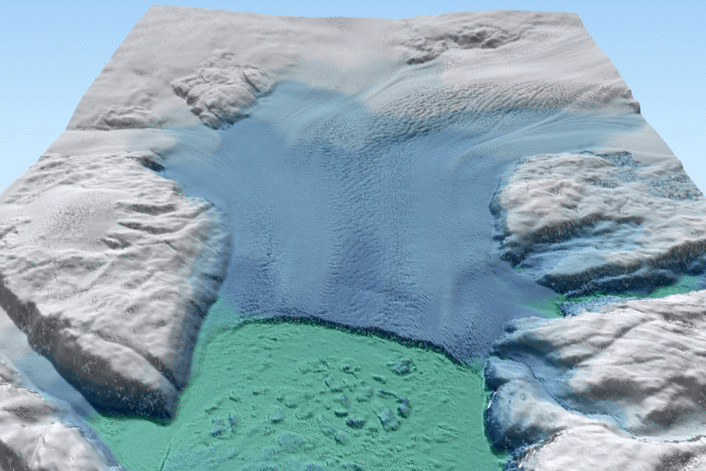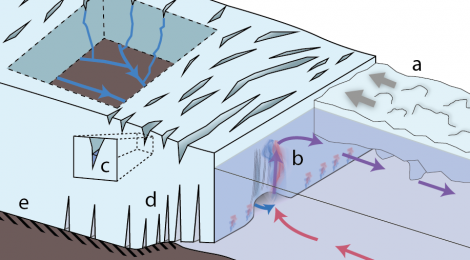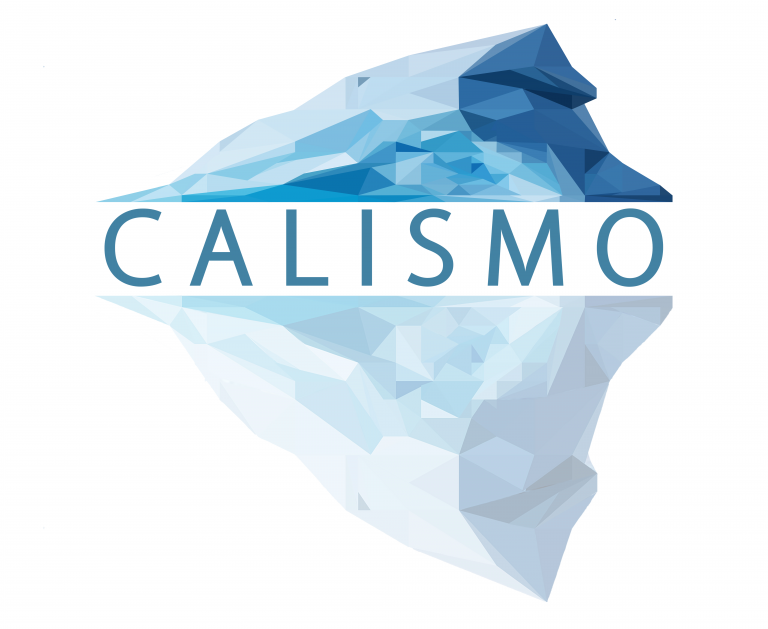CALISMO:
Calving Laws for Ice Sheet Models
CALISMO is a NERC-funded project that aims to radically improve the accuracy of sea-level rise predictions for the 6th Assessment Report of the Intergovernmental Panel on Climate Change (IPCC AR6). The project will:
- develop a rigorous, comprehensive theory of calving processes, critically tested against observations
- apply the knowledge gained from detailed models to develop the simple, reliable calving laws needed to predict ice sheet response to climate change
Working with GeoBus, we have developed some educational material about glaciers and calving which can be found here.

Rationale
The single largest source of uncertainty regarding future sea-level rise is the rate of ice flow into the oceans (dynamic ice losses) from the Antarctic and Greenland Ice Sheets. Predictions of 21st Century sea level rise due to dynamic ice losses from the ice sheets vary from around 10 cm to over 1m under maximum emission scenarios, with widely different implications for coastal societies and economies. Ability to accurately predict the consequences of different greenhouse gas emission scenarios is essential for the implementation of appropriate climate change mitigation strategies.

Calving Processes
Calving processes have a controlling impact on dynamic ice losses from the ice sheets because the breakaway of icebergs from glaciers and floating ice shelves can critically reduce the forces restricting ice flow from land into the oceans. A key weakness in the current methods used to predict sea-level rise is the way in which iceberg calving is represented in ice-sheet models. The current generation of ice sheet models either omit calving processes altogether, or represent them using highly simplified calving laws with little or no physical basis.The overall strategy of CALISMO is to proceed from detailed analysis to general principles, utilizing high-resolution models and observations as benchmarks for developing and testing simpler formulations (calving laws) required by predictive ice-sheet models.
Project Objectives

3) The high-resolution models will be unsuitable for predicting the response of whole ice sheets over years to decades, due to demands of computer resources and other factors. Hence, we will use the results of the detailed model experiments to develop simpler routines (calving laws), capable of replicating the detailed model results at manageable computational cost.
4) In collaboration with project partners, the new calving laws will be implemented in four state-of-the-art models of the Antarctic and Greenland Ice Sheets, to predict their contribution to 21st C sea level rise under a range of greenhouse gas emission scenarios. The models and project partners are: BISICLES (Bristol/Berkeley Ice Sheet Initiative for Climate Extremes: Tony Payne, University of Bristol); 2) the Penn State ice sheet model (David Pollard, Pennsylvania State University), 3) PISM (Parallel Ice Sheet Model: Anders Levermann, Potsdam Institute for Climate Impact Research and Shuting Yang, Danish Meteorological Institute); and 4) The Úa ice sheet model (Hilmar Gudmundsson, British Antarctic Survey).
The Project Team
Doug Benn (PI) is Professor of Environmental Change at the University of St Andrews. His 30 year experience of glaciological research includes the response of glaciers to climate change, glacio-speleology, glacier surges, iceberg calving and glacier dynamics.
Adrian Luckman (Co-I) is Professor of Glaciology and Remote Sensing at the University of Swansea. He has 20 years of experience of satellite remote sensing of the cryosphere, including calving processes, ice dynamics using feature tracking on Synthetic Aperture radar data, and ice shelf processes and stability.
Tom Cowton (Co-I) is lecturer in Physical Geography at the University of St Andrews, with expertise in numerical modelling of feedbacks between glacial runoff, submarine melting and near-glacier ocean circulation using MITgcm and plume theory.
Joe Todd (PDRA) developed the first practical 2D and 3D time-evolving calving models in Elmer/Ice as part of his PhD project at the University of Cambridge. He will develop and apply high-resolution calving models, coupling Elmer/Ice and HiDEM.
Suzanne Bevan (PDRA) has extensive experience of satellite remote sensing of the dynamics of the Greenland and Antarctic Ice Sheets. She will monitor and analyse dynamic and calving behaviour of target glaciers and ice shelves, and provide data for model initialisation and validation.
Collaborators
The calving models will be developed in collaboration with Jan Åström and Thomas Zwinger at the IT Center for Science, Helsinki. Jan is the developer of the Helsinki Discrete Element Model (HiDEM) and Thomas is a core developer of Elmer/Ice.
Project Partners
Tony Payne is Professor of Glaciology at University of Bristol. He was a Lead Author of the Sea Level chapter of IPCC AR5, and was a contributing author on ice-sheet modelling for AR3 & 4. He is co-chair of ISMIP6, and on the steering committee of the WCRP Grand Challenge on Sea-Level Rise.
David Pollard is Senior Scientist at Pennsylvania State University. His implementation of calving laws in numerical models of the Antarctic Ice Sheet suggests extreme sensitivity to anthropogenic forcing.
Anders Levermann is Professor of Dynamics of the Climate System at Potsdam Institute for Climate Impact Research. His research includes modelling of the response of the Antarctic Ice Sheet to greenhouse gas emissions using the Parallel Ice Sheet Model (PISM).
Hilmar Gudmundsson is Work Package Manager in the Ice Dynamics and Palaeoclimate team, British Antarctic Survey. His extensive expertise includes numerical modelling of marine ice sheets.
Shuting Yang is a climate scientist at the Danish Meteorological Institute, using an atmospheric GCM and ice-sheet model (PISM) to predict Greenland Ice Sheet response to climate change.

